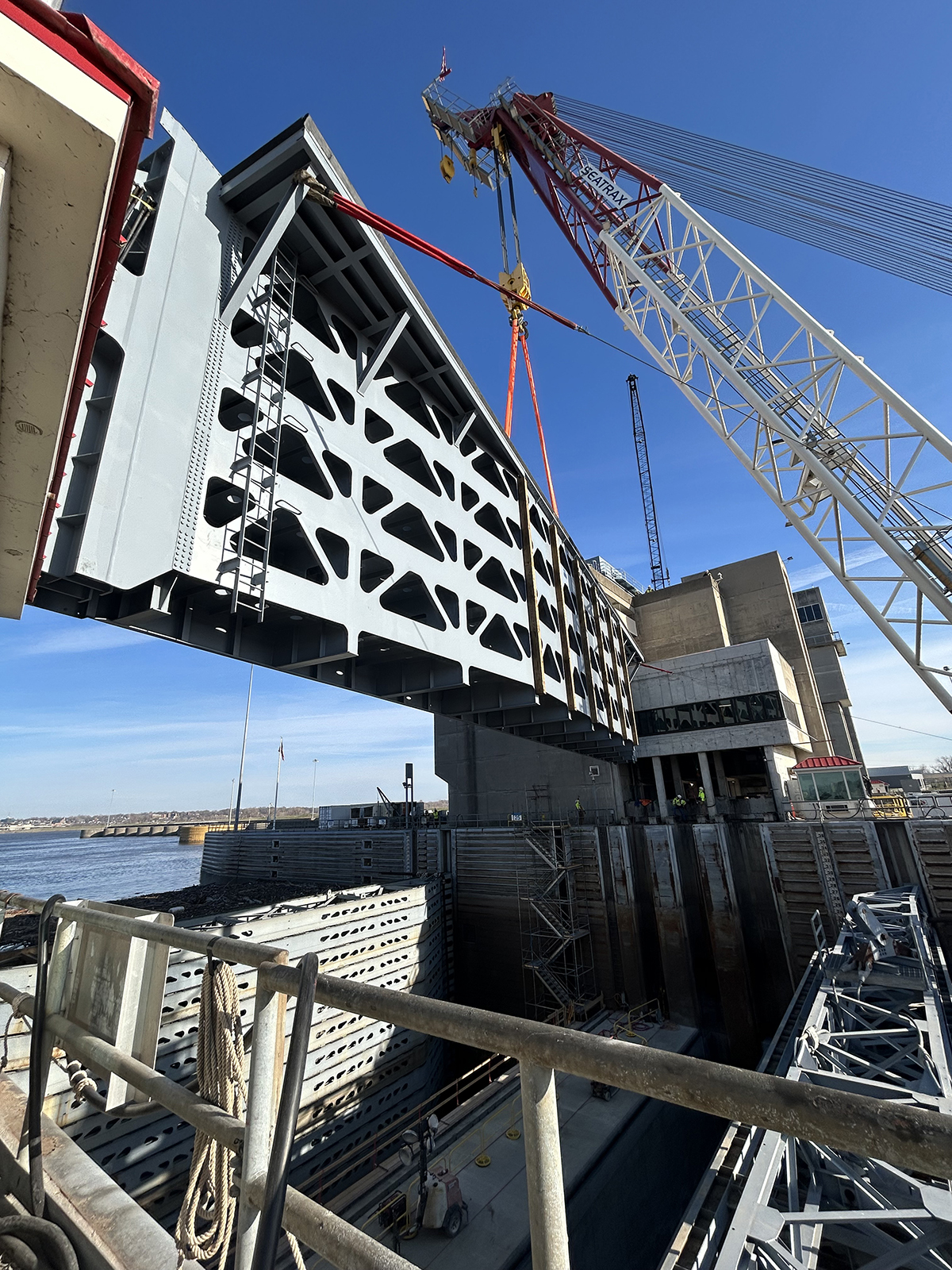Main Lock Reopens At Melvin Price Lock And Dam
The St. Louis Engineer District announced April 15 that the main, 1,200-foot lock chamber at Melvin Price Lock and Dam (Lock and Dam 26) has reopened. The project required a 100-person team and had been named a top priority of the Mississippi Valley Division. A consolidated lock closure allowed for several repair projects and for Locks and Dams 24, 25 and 27 to be completed as well.
Modernizing and completing the lift gate replacement at Melvin Price concluded the third phase in a multi-year maintenance project to improve operational efficiency and ensure navigation on the Upper Mississippi River.
The three leaf lift gates were original to the 1994 design and were built to ensure that the pool elevation could be maintained while the razed Locks and Dam 26 were still in operation. But the design proved to have numerous reliability issues that led to closures and constant maintenance. When engineers found that a permanent global twist in the three-leaf lift gate was unrepairable, along with extensive fatigue cracking and the threat of failure, the gate replacement was elevated to the top priority for repair in the Mississippi Valley Division.

The district’s product delivery team included the Engineering and Construction, Project Management, Contracting and Operations Division working alongside the Rock Island Structures Maintenance Heavy Fleet with the Heavy Lift Quad Cities floating plant and contractors.
A consolidated lock closure allowed for:
• The addition of downstream lifting lugs at Lock and Dam 24 in Clarksville, Mo., for gate removal and maintenance.
• Modifications to Lock and Dam 25, near Winfield, Mo., for the upcoming addition of a new 1,200-foot lock chamber.
• Modernizing and completing the third phase of the lift gate replacement project at Melvin Price Locks and Dam in Alton, Ill.
• Repairing embedded metal used as rub rail inside the lock chamber at Locks 27, near Granite City, Ill.
“Winter maintenance projects are critical to ensuring the sustainability of the navigation system on the Upper Mississippi River,” said Star Loftus, project manager. “In the St. Louis District, Corps staff have focused their efforts on completing these projects, making for a very busy winter, but this is the best time to do maintenance since it has the least effects on the industry.”
Lock and Dam 24 in Clarksville, Mo., was closed for seven days for the installation of downstream miter gate lifting lugs, while the Rock Island Structures Maintenance Medium Fleet and St. Louis District crews worked at Lock and Dam 25 to install a downstream bulkhead recess sill beam and dewater the 600-foot lock chamber to allow for concrete placement around the structure. Additionally, crews worked to place new concrete on the lock guide wall.
This operational milestone advances the team closer to facilitating the new 1,200-foot lock chamber. Currently, Locks and Dams 24 and 25, constructed in the 1930s, each have only a 600-foot lock chamber.
A supply contract for phase one allowed for the approximate 31-month fabrication of the lift gate. Since the upstream leaf weighed approximately 450,000 pounds and the downstream leaf weighed approximately 490,000 pounds, the gates were shipped by river from Alabama to Alton, Ill.
Phase two consisted of alterations to the pier faces to reconstruct the cantilevered control rooms to allow for future installation. Phase three, completed this winter, was the largest and most complicated phase of the project since it included installing bulkheads, dewatering, removing the old gate system, removing and replacing machinery components and lifting cables, placing 1,000 cubic yards of concrete to raise the gate sill and gate rests, painting, setting up a temporary power facility, reconnecting computer systems with the new machinery, shipping and reinstalling two completely modernized gates and rewatering the lock.
Structural, electrical, hydraulic, mechanical, technical and fabrication subject matter experts were on-site daily to review the work, troubleshoot issues and maintain the schedule.
To manage dewatering at all the locations, the team secured bulkheads across the division and dealt with winter weather effects and the intricacies of integrating new electronic systems with old components. However, through close schedule coordination, communication, data management, continuity and construction oversight, the team was able to complete the task.
Lastly, the 1,200-foot lock chamber at Locks and Dam 27 near Granite City, Ill., was dewatered, and crews removed embedded metal from the lock chamber walls. Locks and Dam 27 moves more cargo than any other navigation structure on the Mississippi River. The St. Louis District oversees five locks and dam sites on the Mississippi and Kaskaskia rivers.
“By leveraging coordinated closures to complete necessary major lock maintenance and rehab, the district is able to modernize and rehabilitate key infrastructure supporting the navigation mission, and with spring just around the corner, coal, fertilizer and road salt will begin shipping upriver, so it’s critical that each team worked together to meet the tight deadline,” said Andy Schimpf, rivers project manager.
In the Midwest, 60 percent of grain is shipped on the Mississippi River. During the 2024 season, Corps staff supported nearly 4,800 lockages and the movement of more than 45 million tons of cargo through the Melvin Price Locks and Dam structure.
In conjunction with 25 other such structures on the river to the head of navigation in Minnesota, the last four locks and dams on the Mississippi River facilitate critical navigation on the nation’s largest river.


